
Ever wondered what that extra verification step is when you're paying with your card online? That’s 3D Secure in action.
At its heart, 3D Secure is an added layer of security for online card payments. Think of it as a digital bouncer checking your ID before you enter a club. You might have seen it pop up under names like Visa Secure or Mastercard Identity Check. Its entire purpose is to confirm it’s really you making the purchase, not someone who just stole your card details.
A Simple Guide to 3D Secure Authentication
So, what’s happening behind the scenes? When you punch in your card details to buy something, 3D Secure kicks off a quick, secure conversation between the merchant's website, your bank (the issuer), and the card network (like Visa or Mastercard). Its main job is to stop fraud in its tracks, before the transaction is even completed.
And no, it’s not just another annoying step designed to slow you down. It’s a smart system built to protect both shoppers and online stores. For you, the shopper, it adds a powerful shield against someone using your card without permission. For the business, it dramatically cuts down on fraudulent transactions and the expensive chargebacks that inevitably follow.
To give you a quick rundown, here's a simple look at the core idea behind 3D Secure.
3D Secure at a Glance
This framework makes online payments significantly safer for everyone involved.
Why Does It Matter So Much?
Not too long ago, a card number and CVV were all a fraudster needed to go on an online shopping spree. As e-commerce exploded, so did the clever ways criminals found to exploit this weakness. 3D Secure was created to plug that gap by adding a verification step only the legitimate cardholder can pass. It’s a simple but effective way to separate genuine customers from thieves.
Here’s why this security layer is so critical today:
- It Builds Customer Trust: When shoppers see the Visa Secure or Mastercard Identity Check logo, it gives them confidence that their payment information is being handled safely. Peace of mind is a powerful thing.
- It Fights Online Fraud: 3D Secure is a direct counter-attack against "card-not-present" fraud—the most common type for online stores. The numbers don't lie; this kind of fraud is a massive headache for merchants everywhere.
- It Protects Sensitive Data: While 3D Secure focuses on verifying your identity, it works hand-in-hand with other security measures. Technologies like tokenization, for instance, encrypt your actual card number so it’s never exposed. To see how that works, you can learn more about how tokenization in payments works to encrypt and protect card numbers.
The whole point of 3D Secure is to make absolutely sure the person clicking "buy" is the same person who owns the card. It's a straightforward idea that adds a powerful layer of defense against modern online payment fraud.
Ultimately, understanding 3D Secure authentication means recognizing it for what it is: a crucial safeguard. It helps ensure that your online shopping experience is not just convenient, but genuinely secure for everyone involved.
How a 3D Secure Transaction Actually Works
Ever wonder what happens between clicking 'Buy Now' and seeing that satisfying "Order Confirmed" message? It feels like magic, but in that split second, a secure digital conversation is happening behind the scenes. Think of it as a quick, three-way handshake between the online store, your bank, and the card network (like Visa or Mastercard) to give your purchase the green light.
This whole process is built on what the industry calls the "three domains," which is where 3D Secure gets its name. First, you have the merchant's end (the Acquirer Domain). Then there’s your bank, the one that issued your card (the Issuer Domain). And finally, you have the system that connects them both (the Interoperability Domain). These three work together to swap information in seconds and confirm you're really you.
The Two Paths of Verification
Once you hit submit on your card details, the system gets to work. It instantly analyzes hundreds of little data points—things like your location, the device you're using, and your purchase history—to figure out how risky the transaction might be. Based on that lightning-fast analysis, the payment goes down one of two roads.
The Frictionless Flow: If everything looks normal and lines up with your usual spending habits, the transaction gets a silent thumbs-up in the background. This is the goal—a buttery-smooth checkout with no extra steps. In fact, over 90% of 3D Secure 2 transactions are now totally frictionless.
The Challenge Flow: But what if the system spots something unusual? Maybe you’re buying from a new laptop or shipping to an address you've never used before. If that happens, it triggers a "challenge." This is that extra verification step you've probably seen, where it asks for a one-time code sent to your phone or a quick tap to approve it in your banking app.
This smart, risk-based approach is what makes modern 3D Secure authentication so effective. It lets legitimate, low-risk purchases sail right through while adding a security checkpoint only when it’s genuinely needed.
This flow chart breaks down the simple journey from your shopping cart to a fully verified purchase.
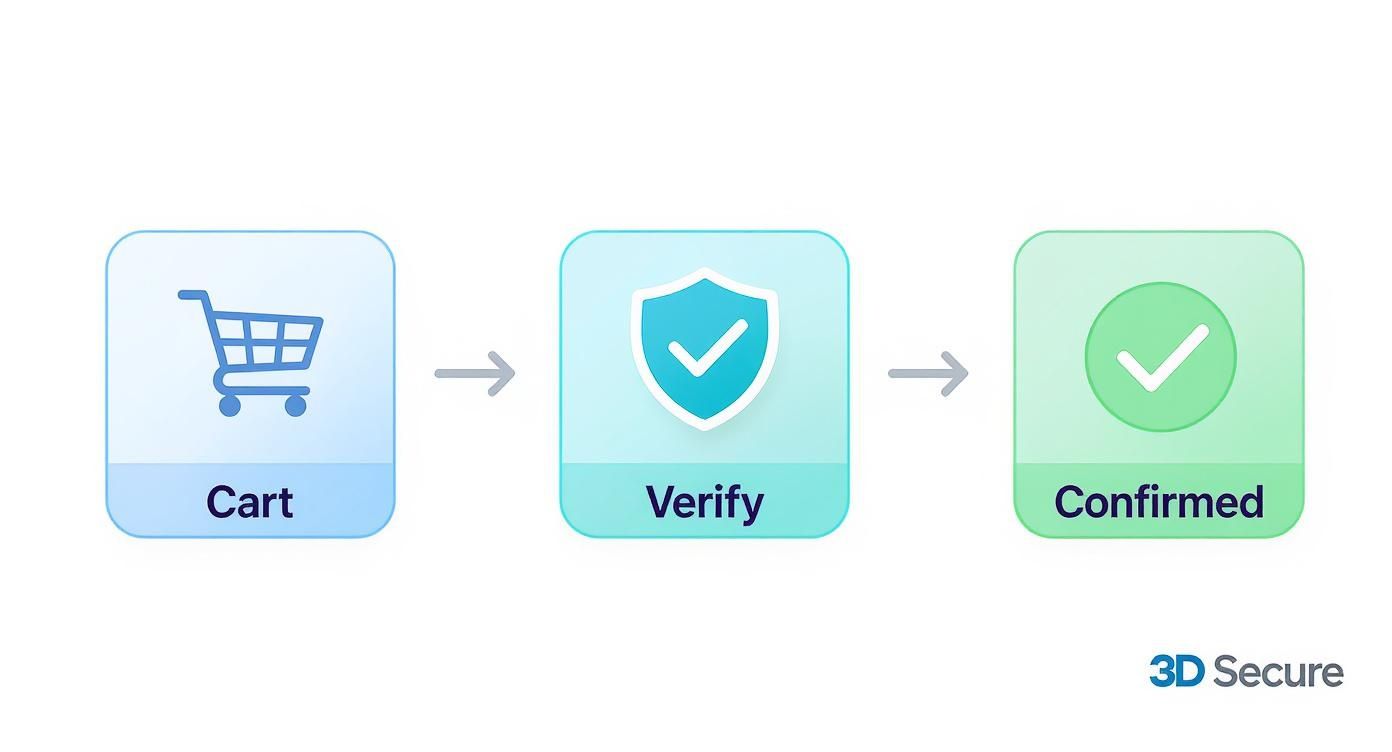
As you can see, even though the behind-the-scenes work is complex, the checkout experience for the customer is designed to be as simple and secure as possible.
This whole sequence is a core part of how online payments work. If you want to get into the nitty-gritty, our guide explains the full lifecycle of credit card transactions from start to finish. At the end of the day, this digital handshake is all about protecting your account from fraud while making online shopping feel effortless.
The Big Leap from 3DS1 to 3DS2
The 3D Secure protocol you see today is a world away from where it started. The original version, 3D Secure 1 (3DS1), was a noble first attempt at adding an extra security layer, but it came with some serious growing pains for shoppers.
If you’ve ever been abruptly redirected to a clunky pop-up window from your bank demanding a password you barely remember setting up, you’ve experienced 3DS1 firsthand. This process was jarring. It yanked you away from the merchant’s website, and the static passwords were easy to forget, leading directly to abandoned carts and frustrated customers. It was designed to stop fraud, but it often ended up stopping legitimate sales, too. It quickly became clear a smarter, smoother approach was needed.

Enter the Smarter Solution: 3DS2
This is where 3D Secure 2 (3DS2) comes in as the modern, intelligent upgrade. Instead of treating every single transaction with the same level of suspicion, 3DS2 works like a clever detective operating silently in the background. It quietly analyzes over 100 different data points in real-time to figure out the risk of each purchase.
This data includes details like:
- Your device information
- Your physical location
- Your purchase history with the merchant
- The transaction amount
This risk-based analysis lets the system make an informed decision in a split second. If everything looks legitimate and matches your usual behavior, the transaction sails through without you having to lift a finger. This is what we call the "frictionless flow," and it’s the goal for the vast majority of online purchases.
The improvements have been dramatic. Since its introduction, 3D Secure 2.0 has completely changed the game, with studies showing that up to 64% of global transactions now pass through this seamless, invisible flow. These advancements make online shopping both safer and way more convenient. If you're interested in the data, you can discover more insights about these payment authentication trends.
3DS2 is designed to be invisible when it can be and only step in when it must. It’s a shift from a one-size-fits-all security hurdle to a tailored, data-driven safety net that protects you without getting in your way.
This intelligent system is a huge leap forward, cementing its role as a cornerstone of modern ecommerce fraud prevention strategies. It strikes a much healthier balance between tight security and a smooth shopping experience. The old way put the burden on the shopper; the new way lets smart technology do the heavy lifting.
Comparing 3D Secure 1 vs 3D Secure 2
To really see how far we've come, it helps to put the two versions side-by-side. The table below breaks down the key differences, from the customer experience to the data used behind the scenes.
As you can see, 3DS2 isn't just a minor update—it's a complete overhaul focused on making security and convenience work together, not against each other. This evolution was essential for meeting the demands of modern ecommerce.
Why 3D Secure Is a Big Deal for Online Businesses
From a business owner's perspective, 3D Secure authentication is much more than just another security check. The single biggest reason to get on board is something called the liability shift. And for anyone selling online, it’s an absolute game-changer.
So what is it? Put simply, the liability shift protects you from the financial gut-punch of certain types of fraud. When a purchase is successfully authenticated with 3D Secure, the responsibility for any resulting fraud usually shifts away from you—the merchant—and back to the bank that issued the card. Think of it as a powerful safety net against expensive chargebacks.

This protection is especially vital for businesses that deal in high-value goods. For anyone, say, successfully launching an online jewelry store, keeping chargeback risk low is the key to maintaining healthy profit margins. This shift in liability is one of the strongest arguments for adopting 3D Secure.
More Than Just a Liability Shift
While dodging chargebacks is a massive win, the advantages don't stop there. Bringing a modern 3D Secure system into your checkout flow delivers several other key benefits that directly impact your bottom line and customer relationships.
- Dramatically Lower Fraud Rates: At its core, 3D Secure is designed to stop fraud before it ever happens. By confirming the cardholder's identity, it acts as a brick wall against criminals trying to use stolen card details.
- Fewer False Declines: Modern 3DS2 systems are smarter. They use rich data to assess risk with incredible accuracy, which means fewer legitimate customers get their transactions incorrectly declined. No more lost sales or frustrated shoppers.
- Increased Customer Trust: When shoppers see logos like Visa Secure or Mastercard Identity Check, it sends a clear signal: you take their security seriously. This builds confidence and can actually nudge conversion rates higher.
Adopting 3D Secure isn’t just about blocking bad transactions; it’s about safely approving more good ones. It creates a more secure environment that benefits both the business and its genuine customers.
Staying Compliant and Secure
Beyond just security, 3D Secure has become a critical tool for legal compliance. In places like Europe, regulations like Strong Customer Authentication (SCA) require this kind of robust verification for most online payments. This makes 3D Secure non-negotiable for any business operating internationally.
The protocol's effectiveness is why its adoption is skyrocketing. In fact, 75% of merchants expect to use it for the majority of their transactions in the coming years. It’s quickly becoming a standard part of any solid chargeback protection plan for merchants who want to stay secure.
How 3D Secure Is Used Around the World
The adoption of 3D Secure authentication isn't just a niche trend; it's become a fundamental piece of the modern global e-commerce puzzle. As online shopping continues its explosive growth, this security protocol has become the standard for businesses looking to protect themselves and their customers from fraud.
This isn't just talk—the numbers back it up. The global market for 3D Secure was already valued between $1.05 billion and $1.29 billion back in 2022. That figure is expected to blast past $3.96 billion by 2032, growing at a blistering pace of nearly 13% every year. Simply put, businesses are investing heavily in this technology because it delivers real results. You can dig into more of the data in this in-depth report on the 3D Secure market.
A Look at Regional Adoption
Adoption isn't happening at the same speed everywhere. Europe, for instance, is way ahead of the curve, largely thanks to regulations like the Payment Services Directive (PSD2). This directive makes Strong Customer Authentication (SCA) mandatory for most online payments, turning 3D Secure from a "nice-to-have" into an essential compliance tool.
Other regions are catching up fast. North America currently commands the largest market share, bringing in over 28% of global revenue. But keep an eye on the Asia-Pacific region, which is set to see the fastest growth as e-commerce continues to boom there. This global momentum proves just how vital 3D Secure has become.
From London to Los Angeles to Tokyo, 3D Secure is the invisible guardian securing trillions of dollars in online payments every single year. It’s the common language of trust between merchants, banks, and shoppers worldwide.
This widespread acceptance makes 3D Secure a must-have for businesses of all sizes. For platforms like Stripe, integrating it is non-negotiable for offering their users robust security. If you're a Stripe user, it's smart to understand how this technology works alongside other security features. Our guide on how Stripe chargeback protection works breaks down how these layers combine to protect your bottom line. At the end of the day, this global shift makes one thing clear: secure, authenticated payments are the future of commerce.
Common Questions About 3D Secure
Even after getting the hang of 3D Secure, a few questions usually pop up. It's totally normal. Think of this section as a quick FAQ where we tackle the most common things we hear from shoppers and merchants alike.
Our goal is to clear up any lingering confusion so you can feel confident, whether you're clicking "buy" or running an online store.
What Does the “3D” in 3D Secure Actually Stand For?
This is easily one of the most common questions, and the answer is way simpler than you'd think. The "3D" stands for Three Domains.
Just picture a secure, three-way digital handshake that happens behind the scenes to make sure a purchase is legit. These three groups, or domains, are:
- The Acquirer Domain: This is the merchant's world—their bank and payment gateway.
- The Issuer Domain: This is your side of the coin, specifically the bank that issued your credit or debit card.
- The Interoperability Domain: This is the bridge that connects the first two. Think Visa or Mastercard, making sure everyone can talk to each other securely.
So, when you see "3D Secure," just remember it's about those three parties working in sync to verify your payment.
Is 3D Secure Mandatory for Every Online Purchase?
Not for every single one, no. But it's quickly becoming the global standard. Whether you run into it often depends on where you are and what you're buying.
In places like Europe, regulations like Strong Customer Authentication (SCA) make this level of security a must-have for most online transactions. 3D Secure is the main way businesses meet that legal requirement. In other parts of the world, it's often the merchant's call. Many opt-in because the benefits are huge, like the liability shift that protects them from certain types of fraud.
For shoppers, this just means you'll see it pop up more for bigger purchases or when buying from international stores. It’s a mix of the merchant's rules, your bank's security policies, and local laws.
How Is 3D Secure Different From the CVV Code on My Card?
Great question. Both are security features, but they play very different roles. The CVV (Card Verification Value) is that static, three or four-digit code printed right on your card. Its only job is to prove you have the physical card in your hands during an online purchase.
3D Secure is a much smarter, more dynamic process. Instead of a fixed code, it pulls your bank into the transaction in real-time to double-check that it’s really you.
Here’s a simple way to think about it:
- CVV: A static code printed on your card. If a fraudster steals your card number, they probably have the CVV, too.
- 3D Secure: A dynamic, real-time check with your bank. It often uses a one-time code sent to your phone or a quick fingerprint scan in your banking app—something a thief won't have.
Bottom line: a CVV confirms you have the card. 3D Secure confirms you are you.
Do I Need to Sign Up or Enroll for 3D Secure?
In the early days, you often did. The original 3D Secure 1 was clunky and made users create and remember a separate password, which was a massive pain.
Thankfully, those days are pretty much gone. With modern 3D Secure 2, your bank usually enrolls your card automatically. There’s no separate signup process needed. The whole system is designed to be invisible. If it does need an extra check, your bank will just prompt you with something you already use, like a notification to your banking app or a text message to your phone.
Navigating the world of online payments and fraud can feel like a full-time job. But you don't have to do it alone. ChargePay uses AI to automate the entire chargeback dispute process, helping you recover lost revenue without lifting a finger. Stop letting fraudulent claims eat into your profits and get back to focusing on growth. Learn how ChargePay can protect your business today.
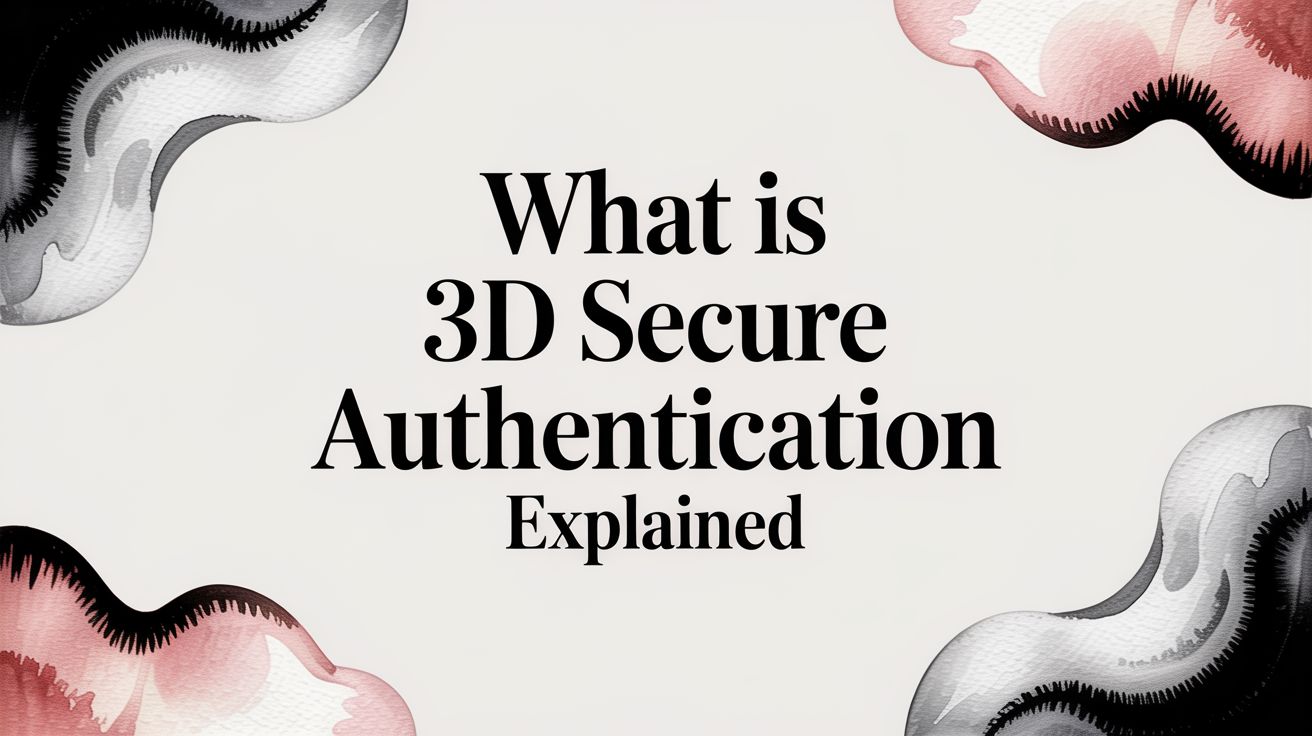


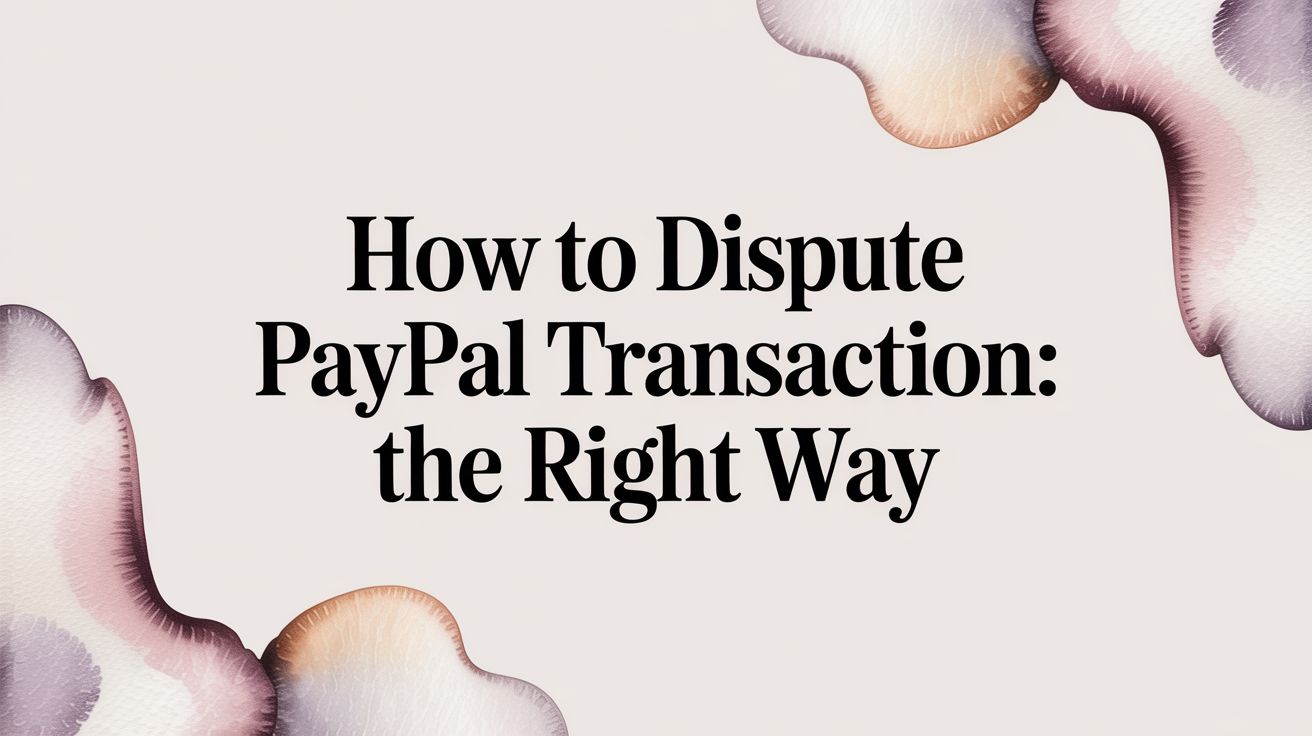
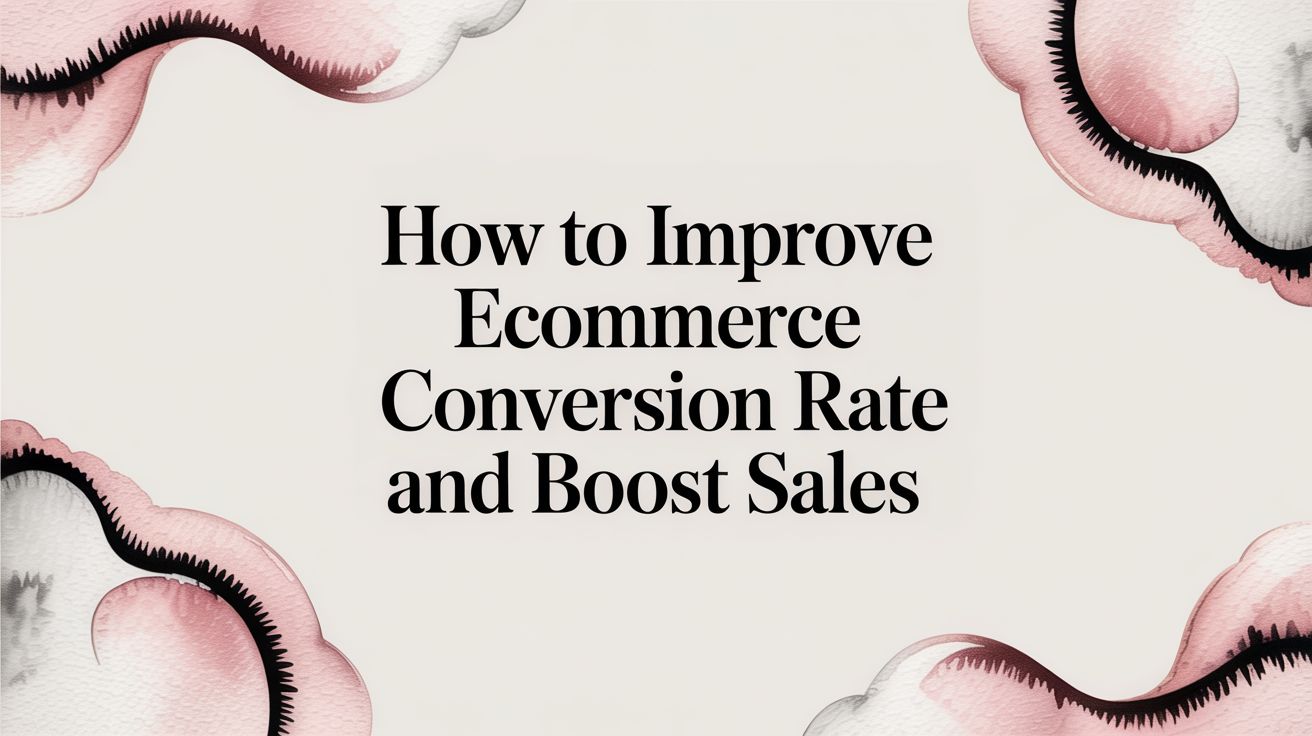
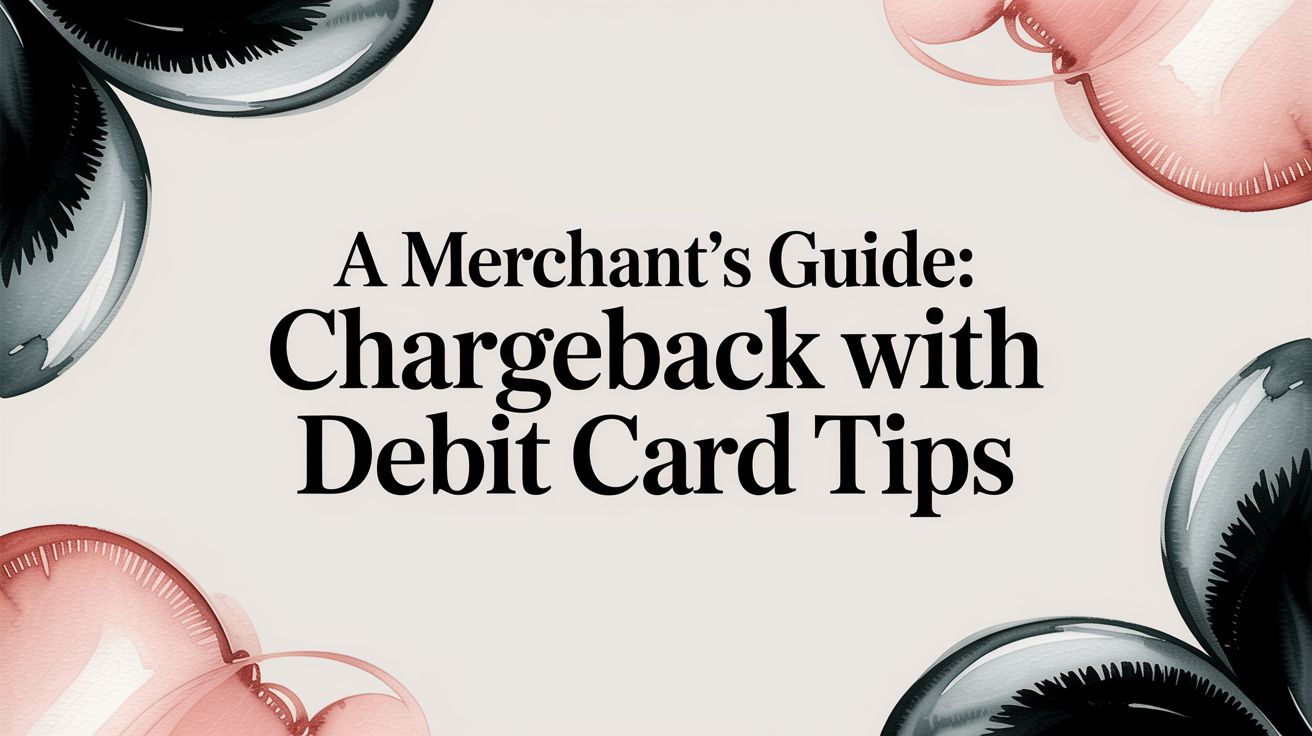

.svg)







.svg)
.svg)
.svg)